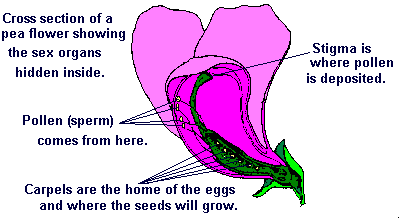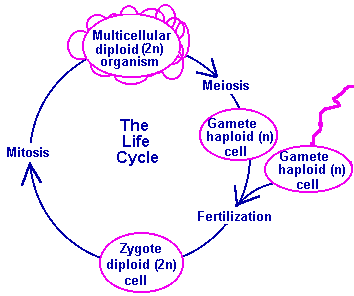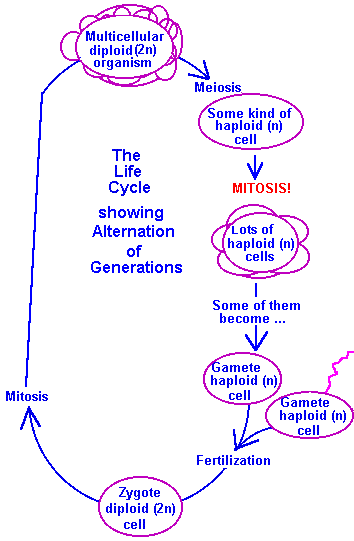
|
Lesson Six
by Dr Jamie Love |

|
 and
and  licensed under a Creative Commons Attribution-ShareAlike 4.0 International License.
licensed under a Creative Commons Attribution-ShareAlike 4.0 International License.

|
Lesson Six
by Dr Jamie Love |

|
We've covered a lot of information in these lessons. You should now have a very clear understanding of chromosomes and the nuclear divisions; mitosis, meiosis I and meiosis II. Now I'd like to introduce you to the genetics of reproduction, life cycles and some rather unusual genetics while also reiterating bits of information you have already learned - but in a different light.
Reproduction is the production of new individuals, called offspring, that are, more or less, similar to the original organism(s), called parent(s). Reproduction serves to perpetuate, if not increase, a species' numbers. There are two kinds of reproduction.
Sexual reproduction requires a cycle that alternates between haploid (n) and diploid (2n) cells. Meiosis is required for sexual reproduction. The offspring from sexual reproduction are not identical to either parent. Instead, offspring from sexual reproduction are a kind of "compromise" between, or a "mixture" of, the parents.
By contrast, asexual reproduction does not alternate between haploid and diploid. Asexual reproduction is nothing more than mitosis and the offspring are exactly like the parent (genetically speaking and not counting mutations) because they are clones.
Perhaps you think that is all so obvious that it does not bear repeating but we will constantly fall back on those definitions to help us to understand some of the more complicated forms of reproduction.
|
Hermaphroditism is the coexistence of both male and female
sex organs, producing male and female gametes, in the same organism.
This is fairly common among invertebrates and very common among plants, where it is called monoecious. It is possible for some species of hermaphrodites, especially plants, to fertilize themselves in a process called "selfing".
This is NOT asexual reproduction! This is sexual reproduction. It's "self-sex". |

|
We will be discussing reproduction of pea plants in the next course (Mendelian Genetics) so take a good look at the drawing above to familiarize yourself with the anatomy of the pea flower. Also, see it as a good example of hermaphroditism.
| Before you ask ... No, hermaphroditism doesn't occur in humans but that doesn't keep the tabloids from misusing the word! Some unfortunate people are born with “ambiguous external genitalia” or have incompletely developed sex organs. The proper medical name for these folks depends upon the specifics (condition, cause, etc.) but they are NOT hermaphrodites! Hermaphrodites are able to use their pair of sex organs to produce both types of gametes and reproduce using them. Humans with the medical complications described in the media as "hermaphrodites" cannot produce both kinds of gametes and usually cannot produce one or the other kind of gamete either so they usually cannot reproduce at all! (But medical treatment might help them to have children. It depends on the specifics.) |
Notice that in order to "self", the organism must first produce
gametes. That requires meiosis and meiosis is the "sign"
for sexual reproduction.
It doesn't take two individuals to have sex - just two sex organs producing opposite gametes!
When a monoecious flower undergoes meiosis it produces thousands of different types of pollen and eggs. Recall all the diversity of gametes caused by crossing over in prophase I and the random segregation (separation) of chromosomes in anaphase I. Those (haploid) gametes will fuse with the opposite gamete to create a (diploid) zygote. The zygote will be unique - different from its parent - because it has different combinations of different chromosomes. [This assumes the parent was not highly inbred. Most individuals are outbreed. We will come back to this in the next course.]
Imagine a plant with #1M and #1P producing gametes carrying either #1M or #1P. It would produce thousands of these and it is possible that an egg carrying #1M could be fertilized with a pollen carrying #1M to produce a zygote that is #1M, 1#M. That is slightly different from the parent that had #1M, 1#P. [We will come back to this when we move on to Mendelian Genetics - but think about it now.]
Horticulturists and other plant breeders use selfing in order to conduct very specific experiments and we will be using examples of selfing, in garden peas, as the basis upon which you will learn Mendelian genetics. So it is important for you to accept and understand that selfing is sexual reproduction!
Leaving selfing behind for a moment, many plants can also reproduce
asexually. Many plants send out shoots or runners that are simply
extensions of themselves. These can break away from the parent
body and generate a new individual but that individual will be
an exact copy, a clone, of its parent.
Plant breeders use variations on this natural form of asexual
reproduction to make copies of individual plants that they find
particularly interesting and hope to propagate. This is called
"taking a cutting". Cuttings are clones of the parent.
Notice throughout these descriptions of cuttings, shoots and runners
that meiosis never contributes. There are no gametes. Only mitosis
is involved in asexual reproduction. The "sign" for
asexual reproduction is the total lack of meiosis, gametes or
fertilization - it's mitosis all the way!
When animals reproduce asexually we call it parthenogenesis.
("Parthenos" is Greek for "virgin".) These
species are often called "all female species" because
they have no males in the population. They don't need males so why have them?
Many species of water flea (Daphnia) reproduce asexually.
All her children are tiny copies of the mother. Several species
of fish, amphibians and lizards are also parthenogenic.
Thanks to recent advances in biotechnology, today we can clone mammals! Dolly was created without meiosis, gametes or fertilization so she was an exact copy of her "mother". The ewe (female sheep) that gave birth to Dolly was just a surrogate mother. Dolly's genetic mother died years before but her breast cells were propagated in tissue culture in order to provide the genetic material that went into Dolly. The path of genetic material from Dolly's genetic mother to Dolly was entirely by mitosis. [If you want to learn the full story of Dolly, have a look at my website at http://www.synapses.co.uk/science/clone.html.]
As exciting and strange as cloning is, it's very boring from
the standpoint of genetics. Without meiosis and fertilization (including selfing), the only way to introduce variety into a population is directly through mutations and that is a very ineffective way to evolve. (Ask a bacterium.  )
Variations in populations are the "fertilizer"
upon which evolution grows. Even hermaphrodites prefer to mate
with someone else. (The reason why is a bit complicated and has
to do with evolutionary theory.)
)
Variations in populations are the "fertilizer"
upon which evolution grows. Even hermaphrodites prefer to mate
with someone else. (The reason why is a bit complicated and has
to do with evolutionary theory.)
With few exceptions, we will be discussing sexual reproduction throughout the rest of this course. However, I'd now like to teach you about "alternation of generations". This is unusual and some folks find it confusing at first so we will start with some introductory material that may seem obvious to you but it will get you in the right frame of mind to move onto the "weirdness" of alternation of generations.
|
Fusion (fertilization) causes two haploid cells (gametes) to create a unique diploid cell (zygote).
The zygote undergoes many mitotic and cellular divisions to create a multicellular organism like a baby. That baby matures and a few of its cells undergo meiosis to create haploid gametes and the whole cycle starts again.
The life cycle is the span of the life of an organism from
the moment of fertilization to the time it reproduces. Don't confuse
this with "life span" which extends beyond the time
of reproduction. [Although most parents would argue that their
life is over the moment they have kids! This life cycle I've drawn on the right is obvious and easy to understand, probably because it is the one humans use. Take a good look at it and understand it. |

|
From our perspective, the haploid stage is merely a requirement to make a zygote.
Our haploid cells, once created, do "nothing". They just
hang around waiting to fertilize something or to be fertilized!
Our diploid (2n) cells undergo mitosis but our haploid (n) cells
NEVER undergo mitosis. However, this isn't true of all organisms.
In some organisms the haploid (n) phase may undergo mitosis  and these cells may make up a substantial portion of an organism
and its life cycle! and these cells may make up a substantial portion of an organism
and its life cycle!
An organism that undergoes mitosis of its haploid cells is said to have alternation of generations. In fungi and mosses the haploid phase is a very prominent phase and in some algae (such as sea lettuce, Ulva lactuca) the haploid plant dominates the life cycle. Indeed, among these "primitive plants" it is often difficult to tell which is the "adult" stage and which is merely the haploid. Many species of "primitive" plants use alternation of generations during their life cycle but among vascular plants the diploid (2n) phase dominates. Alternation of generations is more common in "primitive" organisms and is rare in animals. Male wasps and honeybees are among the few animals I know that are "made" of haploid (n) cells. (These insects are rather exceptional and have evolved this "trick" as a form of sex determination.) Some parasites also go through a life cycle that involves an alternation of generations. Among the ferns, fungi and algae that show an alternation of generations, each taxon has its own name for each part of their complex life cycle. You can learn all about them in a Botany course, but for our purposes all you need to know about alternation of generations is how it works in general, as shown in this diagram on the right. |

|
We use the term "alternation of generations" to describe
life cycles that include both haploid and diploid stages that
are both multicellular.
[Unfortunately, some textbooks and teachers use the phrase "alternation of generations" to describe life cycles which include radical changes in morphology, such as the alternation between the medusa and polyp stage that corals and jellyfish go through. It is a sad fact the geneticists and zoologists have used this phrase to mean different things. For our purposes, in this course, we will be using the phrase "alternation of generations" exclusively to refer to the drawing above.]
This concludes your first course in Genetics! You have learned
a great deal about chromosomes in this course but there is still
a lot more you could learn about them. (Some of which I teach you as we continue through our other courses.) Most students learn to accept the fundamental ideas about chromosomes but still
have trouble remembering the important features of M&M and
how they fit into the cell cycle.
Therefore, I've included below a useful guide
to help you compare mitosis and meiosis. It is only a study sheet
and it is not complete in the details or definitions you are expected
to know, but you may find it a helpful summary of these complex
processes.
"Why didn't you give me this study sheet earlier on?", you ask.
Because most students try to study ONLY this study sheet and eventually
get lost or confused. You are now at a point in your education
in which you can make sense of this complicated chart.
Don't let this chart mislead you - interphase and cytokinesis are NOT part of nuclear division, but it helps to show them in the same table because it's easy to follow. By reading down a column you will walk through all the relevant stages in their correct order. By scanning across you will read how each stage is similar to or different from the equivalent stage.
| Interphase | DNA and Centrosomes duplicate. | DNA and Centrosomes duplicate. | Centrosomes duplicate but DNA does not duplicate. |
|
|
|
| |
| Prophase | Chromosomes appear, centrioles migrate to opposite sides and grow spindles. | Same as mitosis plus homologous pairs synapse and crossing over occurs. | Just like mitosis. (Note that Telophase I may not have added much anyway.) |
| Prometaphase | Nuclear envelope breaks down and microtubules attach to twin kinetochores. "Tug-of-war" moves chromosomes back and forth. | Same as mitosis except only one kinetochore per chromosome. "Tug-of-war" is between tetrads formed by chiasmata linked dyads. | Like mitosis. (Note that there are two kinetochores on each chromosome.) |
| Metaphase | "Tug-of-war" ends in a "draw", with all dyads along the metaphase plate. | "Tug-of-war" ends in a "draw", with all tetrads along the metaphase plate. | Like mitosis except there are only half as many dyads at the metaphase plate. |
| Anaphase | Chromatids separate (chromatids become chromosomes) and migrate to opposite poles. | Chromosomes/dyads separate (chromosomes/dyads remain intact) and migrate to opposite poles. | Like mitosis. |
| Telophase | Chromosomes decondense and a nuclear envelope reforms. | Same as mitosis or it may not occur at all (depending on the species). | Like mitosis |
| Comments | One 2n nucleus became two 2n nuclei. This cell is 4n! (But not for long.) | One diploid nucleus became two haploid nuclei but this cell is still diploid until ... | Each haploid (1n) nucleus became two haploid nuclei. Cell is diploid until ... |
|
| Cell membrane divides cell and separates the two (2n) nuclei. | Cell membrane divides cell and separates the two (1n) nuclei. | Cell membrane divides cell and separates the two (1n) nuclei. |
| Comments | Now we have two cells that are diploid (2n). | Now we have two cells that are haploid (1n). | Now we have four cells that are haploid. |
| Final Comment |
One diploid mother cell produces two diploid daughter cells.
Note that chromatids become chromosomes so "n" does not change. Most cells/nuclei divide by mitosis. This is used for clones & asexual reproduction. |
One diploid mother cell produces two haploid daughter cells.
Prophase is very long due to all the crossing over. Anaphase I is the point of "reduction division". Chromosomes do not split (chromatids do not become chromosomes). Now go to top of next column! |
Two haploid (1n) cells became four haploid cells.
Note that chromatids become chromosomes so "n" does not change. Because meiosis II follows meiosis I, we often say (correctly) that meiosis turns one diploid nucleus into four haploid nuclei. |
 and
and  licensed under a Creative Commons Attribution-ShareAlike 4.0 International License.
licensed under a Creative Commons Attribution-ShareAlike 4.0 International License.
| Table of Contents | Homepage | How to get a FREE copy of the entire course (hypertextbook) | Frequently Asked Questions |